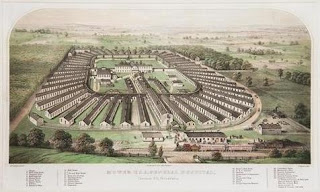It certainly looked like an institutional portrait, of course, but I never gave it much thought until now. The main reason for this new-found interest in the piece was finding period photographs of the site online. Our piece is a small oil painting (about 10" x 25") by an unknown artist depicting the Mower U. S. Army Hospital in the Chestnut Hill section of Philadelphia. We have known for a long time that it was based on a lithograph of the hospital issued in 1863 (below). We didn’t know, or didn’t realize until recently, that the Library Company of Philadelphia has an online database of images of the hospital from the same time period by Philadelphia photographer John Moran.
The Mower U. S. Army Hospital was opened in January 1863 to serve the Union army, and at the time it was one of the largest Federal military hospitals. The Union wounded were sent from Southern battlefields by train to Mower from 1863 until the end of the war in 1865. The hospital had 3,600 beds, and treated more than 20,000 wounded or ill soldiers during the course of the war. It was a state-of-the-art medical facility, with indoor plumbing and hot water, isolation wards for patients with infections, and a centralized storage area for speed and efficiency in treating the patients.
The design was really ideal. Architect John McArthur, Jr. (who also designed Philadelphia’s City Hall) created a central compound from which no fewer than 47 wings radiate outward. The Reading Railroad went right to its front door.
Our little oil is a pretty good rendition of the lithograph, with some nice touches that the artist added, including emphasizing the patterns created by the radiating buildings and enhancing the landscape around the complex. But the real treat is comparing the period photographs with the renderings of both the artist and lithographer. The hospital was a real place, and its visceral reality adds depth and meaning to its artistic representation.

















Wow, what a fabulous discovery!
ReplyDeleteYes, it is. Thanks, Christine!
ReplyDelete